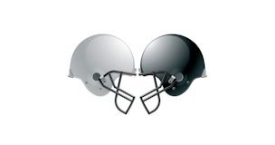Football Helmets May Protect Against Wrong Force

More and more evidence supports the belief that traumatic brain injuries in football tend to be caused by “rotational,” as opposed to “linear,” forces on the brain. Writer Tom Foster explores this important distinction in his article for Popular Science entitled, “The Helmet That Can Save Football.”
Linear forces are straight forward, literally; they hit the impact surface (in this case, the helmet) straight on inflicting a direct line of force. Rotational forces, on the other hand, are forces that strike the skull at an angle. In the barely controlled chaos of football, linear collisions are much less likely than collisions involving angular forces. This is due in part to the rounded shape of the helmet.
The problem with today’s helmets (as well as those of the past) is that they fail to address angular forces. These rotational forces, the theory goes, “twist” and strain the brain tissue more than linear forces, resulting in greater nerve injury (i.e., concussions). Current helmets are designed to protect against linear forces. To illustrate this point, Tom Foster describes the principal method by which football helmets have been tested for the last 40 years:
Picture the head of a typical crash-test dummy, the kind you see in car commercials. It’s attached to a rigid metal arm that hangs above a cylindrical anvil topped with a hard plastic disc. A lab technician straps a football helmet to the head form, cranks the arm up to precisely five feet above the anvil, and lets it drop—crack.
While such a test ensures that a player’s skull will not be crushed, it does little to address the rotational forces acting on his brain.
The solution? A company out of Sweden thinks it might have one. The solution is not more padding or a stronger shell. Instead, the equipment, officially named the “Multidirectional Impact Protection System” or “MIPS,” simulates the skull’s own defense mechanisms. Tom Foster explains:
In a MIPS-equipped helmet, a thin layer of molded plastic fits atop a player’s head, beneath the padding and hard polycarbonate shell. Rubber straps affix the MIPS layer to the helmet.
* * *
MIPS mimics the human head’s own protective system, in which a layer of slippery cerebrospinal fluid sits between the brain and the skull. When an impact occurs, the skull can rotate just a bit relative to the brain. With MIPS, the rubber straps allow the helmet to move just a bit relative to the sliding, low-friction head cap, thereby eliminating much of the twisting motion before it reaches the brain.
MIPS’ designers claim their product reduces brain rotation by as much as 40 to 50 percent.
So why wouldn’t football manufacturers and the NFL jump all over this technology? Foster attributes their hesitation to a mix of factors, including laziness and legal concerns about prior claims of safety regarding existing helmets.
Whether it’s MIPS or something else, one can only hope that some solution is found sooner than later.

